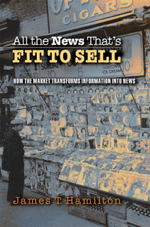 [Here’s Martin’s review of Chapter 3 of this month’s Nieman Journalism Lab Book Club selection. For more info, check here. —Ed.]
[Here’s Martin’s review of Chapter 3 of this month’s Nieman Journalism Lab Book Club selection. For more info, check here. —Ed.]
James Hamilton begins Chapter 3 of All the News that’s Fit to Sell with a question that frames a long-standing debate within and surrounding the media industry: “Do the media provide people with the information they want or the information they need?”
When I started out in the newspaper business in the late 1970s, there were still plenty of old-school editors around — the Lou Grant types whose only tone of voice was gruff, who typed with two fingers, and who (one imagined) still had a hat with a press pass stuck in the brim and a bottle of whiskey in the bottom desk drawer. They were schooled in objective journalism and in the newspaper as an institution providing a great public service, resented references to the paper as as a “product,” would throw us advertising hacks out of the newsroom if we suggested or requested any small editorial favor for our customers, and firmly believed that indeed, their job was to give people news they needed, with “need” defined by them, the almighty editors. They would have no use for surveys to find out what people “wanted”; they made only a few concessions to perceived wants, such as tolerating in the paper non-hard-news features like comics and the “women’s pages.”
But the television news market was never like this — from TV’s earliest days, it was clear that most programs were tailored for specific slices of the viewing audience. The varying demographics of those audience slices differed in value to advertisers, who were willing to pay premium ad rates (expressed as “cost per thousand” or CPM) for a more valuable audience mix — one more responsive to their particular messages. Eventually, this evolved into the highly sophisticated slicing and dicing of an audience that’s now spread across a multiplicity of channels.
This type of targeting is most obvious on the entertainment side of TV content, where it is not hard to discern the program director’s intentions to appeal to younger or older viewers, males or females, sports fans, music fans, cooking enthusiasts, and so forth. But it’s less obvious that different news programs also appeal to demographically distinct audiences, and that these differences are intentional.
Hamilton demonstrates this through an exhaustive set of economic analyses of surveys exploring TV news audiences: their viewing habits and preferences, their political leanings, their news topic priorities and their perceptions of broadcaster bias. Ultimately he concludes that news content producers do indeed select and package topics with an intentional (but not huge) bias toward liberalism. This is driven not by ideology on the part of network owners or managers, but by their preference for demographic groups (especially younger women) that have more influence over spending decisions of value to advertisers and therefore command a higher CPM. In doing this, programmers are reaching for a marginal audience, hoping to enhance the value of the audience mix. They essentially take for granted the larger, more loyal core audience, which is the over-50 crowd.
In other words, news programmers insert content they know is “wanted” by the more liberal, younger, female groups in order to enhance profitability; in so doing, they create a content mix that’s perceived as having a liberal bias by the older, more conservative groups that have a lower value to advertisers. It’s an economic, rather than ideological explanation for perceived news content bias.
He then goes on to show that regular voters are more likely to view media with hard news content. For example, more than 50 percent of devotees of programming like News Hour with Jim Lehrer, C-SPAN and National Public Radio, and publications like Time, Newsweek, U.S. News and World Report, Fortune and Forbes reported that they always vote. By contrast, less than 35 percent of the audience for publications like People and National Inquirer, and shows like Cops, America’s Most Wanted and Jerry Springer report that they always vote. One might confidently guess that result, but Hamilton backs it up with data and suggests that as a result, program directors in their quest for marginal viewers have more incentive to present soft news aimed at younger, marginal viewers who also happen to be marginal voters, regardless of the dissatisfaction this induces among older viewers, or its effect on the functioning of democratic machinery.
And yet, Hamilton shows, the “market for political information” works well enough that even less-frequent voters who are less well-informed and are not attracted to hard news programs still get enough information at least to be able to correctly rank a set of prominent candidates on a political spectrum.
I have one caveat for Hamilton’s readers, one quibble, and one wish: